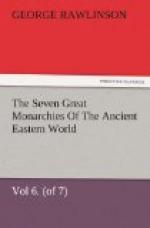The Parthian institutions possessed great simplicity; and it is probable that they took a shape in the reign of Arsaces I., or, at any rate, of Tiridates, which was not greatly altered afterwards. Permanency is the law of Oriental governments; and in a monarchy which lasted less than five hundred years, it is not likely that many changes occurred. The Parthian institutions are referred to Mithridates I., rather than to Tiridates, because in the reign of Mithridates Parthia entered upon a new phase of her existence—became an empire instead of a mere monarchy; and the sovereign of the time could not but have reviewed the circumstances of his State, and have determined either to adopt the previous institutions of his country, or to reject them. Mithridates I. had attained a position which entitled and enabled him to settle the Parthian constitution as he thought best; and, if he maintained an earlier arrangement, which is uncertain, he must have done so of his own free will, simply because he preferred the existing Parthian institutions to any other. Thus the institutions may be regarded as starting from him, since he approved them, and made them those of the Parthian empire.
Like most sovereignties which have arisen out of an association of chiefs banding themselves together for warlike purposes under a single head, the Parthian monarchy was limited. The king was permanently advised by two councils, consisting of persons not of his own nomination, whom rights, conferred by birth or office, entitled to their seats. One of these was a family conclave (concilium domesticum), or assembly of the full-grown males of the Royal House; the other was a Senate comprising both the spiritual and the temporal chiefs of the nation, the Sophi, or “Wise Men,” and the Magi, or “Priests.” Together these two bodies constituted the Megistanes, the “Nobles” or “Great Men”—the privileged class which to a considerable extent checked and controlled the monarch. The monarchy was elective, but only in the house of the Arsacidae; and the concurrent vote of both councils was necessary in the appointment of a new king. Practically, the ordinary law of hereditary descent appears to have been followed, unless in the case where a king left no son of sufficient age to exercise the royal office. Under such circumstances, the Megistanes usually nominated the late king’s next brother to succeed him, or, if he had left behind him no brother, went back to an uncle. When the line of succession had once been changed, the right of the elder branch was lost, and did not revive unless the branch preferred died out or possessed no member qualified to rule. When a king had been duly nominated by the two councils, the right of placing the diadem upon his head belonged to the Surena, the “Field-Marshal,” or “Commander in Chief of the Parthian armies.” The Megistanes further claimed and sometimes exercised the right of deposing a monarch whose conduct displeased them; but an attempt to exercise this privilege was sure to be followed by a civil war, no monarch accepting his deposition without a struggle; and force, not right, practically determining whether he should remain king or no.




